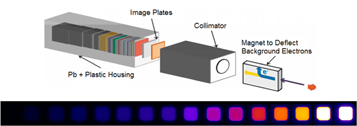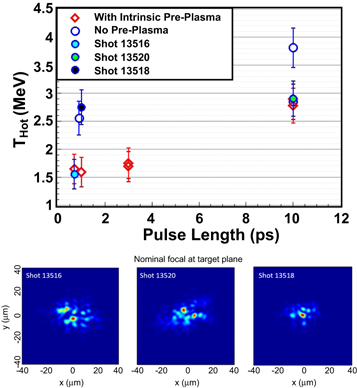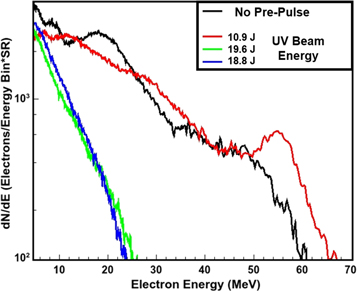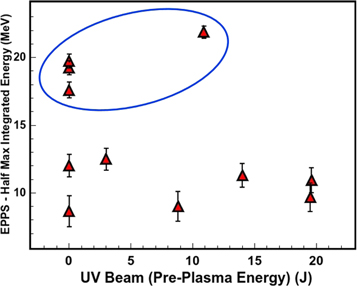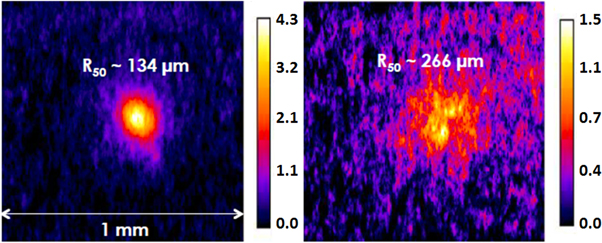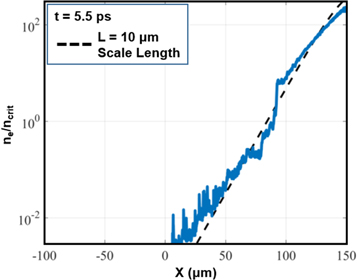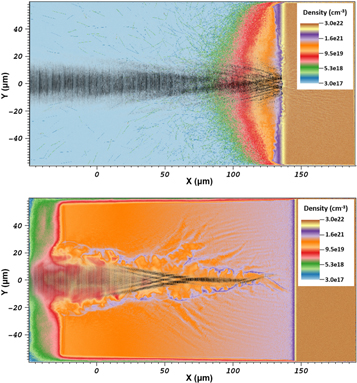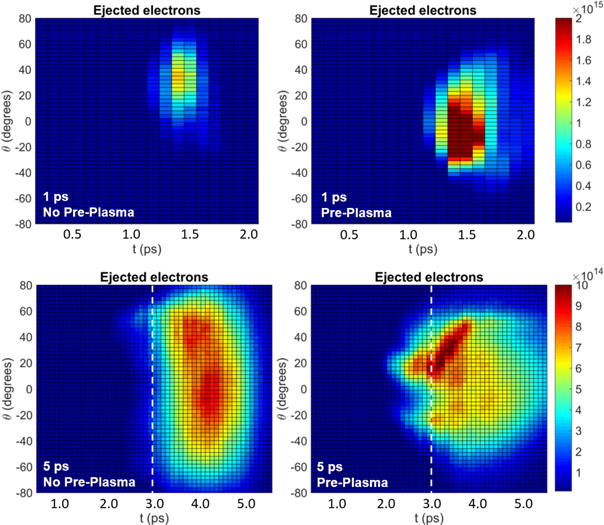Abstract
A series of experiments studying pre-plasma's effect on electron generation and transport due to a high intensity laser were conducted on the OMEGA-EP laser facility. A controlled pre-plasma was produced in front of an aluminum foil target prior to the arrival of the high intensity short pulse beam. Energetic electron spectra were characterized with magnetic and bremsstrahlung spectrometers. Pre-plasma and pulse length were shown to have a large impact on the temperature of lower energy, ponderomotive scaling electrons. Super-ponderomotive electrons, seen in prior pre-plasma experiments with shorter pulses, were observed without any initial pre-plasma in our experiment. 2D particle-in-cell and radiation-hydrodynamic simulations shed light on and validate these experimental results.
Export citation and abstract BibTeX RIS
1. Introduction
The advent of relativistic high intensity lasers  holds great potential for many applications such as high energy density science, generating high energy x-ray backlighters, accelerating high energy particle beams and delivering energy to pre-compressed fuel in alternative inertial confinement fusion concepts [1–3]. However as intensity has increased on relativistic laser platforms, the long ns pre-pulse pedestal that arrives prior to the main interaction intensifies as well. This pre-pulse, generated by amplified spontaneous emission processes in the laser, typically has an intensity contrast ratio
holds great potential for many applications such as high energy density science, generating high energy x-ray backlighters, accelerating high energy particle beams and delivering energy to pre-compressed fuel in alternative inertial confinement fusion concepts [1–3]. However as intensity has increased on relativistic laser platforms, the long ns pre-pulse pedestal that arrives prior to the main interaction intensifies as well. This pre-pulse, generated by amplified spontaneous emission processes in the laser, typically has an intensity contrast ratio  of 106. In high intensity interactions this contrast ratio results in a pre-pulse of high enough intensity to ionize material, creating a pre-plasma extending microns and even millimeters [4]. This pre-plasma significantly impacts the subsequent interaction between the main pulse and the target, altering the characteristics of particles generated by such interactions.
of 106. In high intensity interactions this contrast ratio results in a pre-pulse of high enough intensity to ionize material, creating a pre-plasma extending microns and even millimeters [4]. This pre-plasma significantly impacts the subsequent interaction between the main pulse and the target, altering the characteristics of particles generated by such interactions.
Early studies on laser-plasma interactions considered a moderately relativistic laser pulse irradiating an overcritical target. In this case both transverse and longitudinal momentum components of the electrons accelerated at the surface are comparable to  . It was shown that the electron energy spectrum has an exponential shape with a slope that scales as
. It was shown that the electron energy spectrum has an exponential shape with a slope that scales as  [8]. This relation called ponderomotive scaling uses THot as the characteristic average energy of the distribution. Prior pre-plasma experiments with cone target geometries have been performed by Higginson et al [4] and Ma et al [5], and have demonstrated that the presence of pre-plasma reduces the temperature and quantity of these ponderomotive scaling electrons.
[8]. This relation called ponderomotive scaling uses THot as the characteristic average energy of the distribution. Prior pre-plasma experiments with cone target geometries have been performed by Higginson et al [4] and Ma et al [5], and have demonstrated that the presence of pre-plasma reduces the temperature and quantity of these ponderomotive scaling electrons.
Further experiments with planar geometry targets were conducted by Tanaka et al [6] and Yabuuchi et al [7], which used a controlled long pulse beam to generate a pre-plasma. The electron generating beam in these planar experiments had intensities between 1018–1019 W cm–2 and pulse durations between 0.5 and 1.0 ps. These experiments showed that the electron spectrum can significantly change due to an underdense pre-plasma. The reported spectra have a pronounced two-component structure; the low energy component has a slope predicted by ponderomotive scaling, while additionally there is a hot electron tail with energies that can significantly exceed  , the maximum energy of a free electron accelerated by a plane wave in a vacuum [14]. It is convenient to differentiate these two components of energetic electrons. In what follows, we define a super-pondermotive hot tail as the part of the distribution where electron energies significantly exceed
, the maximum energy of a free electron accelerated by a plane wave in a vacuum [14]. It is convenient to differentiate these two components of energetic electrons. In what follows, we define a super-pondermotive hot tail as the part of the distribution where electron energies significantly exceed  and do not conform to the slope temperature given by ponderomotive scaling. The component of the spectrum which does conform to this scaling and has an energy range not exceeding
and do not conform to the slope temperature given by ponderomotive scaling. The component of the spectrum which does conform to this scaling and has an energy range not exceeding  is referred to as ponderomotive electrons.
is referred to as ponderomotive electrons.
The energy of super-ponderomotive electrons enables high energy transfer from the laser pulse into the generation of x-rays and other secondary particles such as high energy ions [9] and neutrons [10]. The source of these electrons was investigated via 1 and 2D PIC simulations, which showed that an electrostatic potential well develops in the pre-plasma which traps electrons. Simulations performed by Robinson et al [11], Sorokovikova et al [12], Krygier [13] and Arefiev et al [14] show these electrons gain large amounts of energy from direct laser acceleration after being trapped and pre-accelerated inside the potential. Simulations performed by Paradkar et al [15] show that stochastic heating of trapped electrons in the potential well is also a source of these electrons.
Longer pulse length experiments examining high intensity beam interactions with underdense plasmas have been conducted by Willingale et al [16], which have demonstrated extensive filamentation of the beam as it passes through an extended underdense plasma. However, further experiments using longer high intensity pulses on higher Z metal targets are limited. Further understanding these interactions on a longer time scale is important, as multiple future experiments will be using multi-kilojoule, high intensity pulses. Of particular interest is how beam filamentation and electron spread changes over a longer pulse, and how the different components of the electron spectrum evolve over time. Simulations without pre-plasma using longer pulses were described by Kemp in previous work and show that self heated plasma expansion impacts the propagation of generated electron filaments [17]. To examine the impact of pre-plasma for the longer pulse regime we conducted a series of experiments using the OMEGA-EP laser, which features high intensity beams with high contrast for pulse durations of 10 ps. This paper reviews the results from this experiment as well as its subsequent analysis and comparison to simulations. Section 2 describes the diagnostic setup and laser parameters chosen for the experiment and section 3 covers the experimental results from the experiments and the analysis techniques for the diagnostics. Section 4 shows the results from 1 and 2D PIC simulations conducted following the experiments, while section 5 summarizes the results and discusses future work.
2. Experimental setup and diagnostics
The OMEGA-EP laser systems features four beams, two of which have been compressed to give high intensities at shorter pulse lengths. These beams have a peak intensity of  W cm–2 with 80% of the total energy (1.25–1.5 kJ for a 10 ps pulse) contained in a roughly 15–20 μm radius spot. One of these beams was incident normally onto a multilayer foil target, composed of a 135 μm layer of aluminum, 20 μm layer of copper for Cu–Kα imaging, an additional 20 μm layer of aluminum and a 1 mm thick layer of plastic used to reduce electron refluxing in the copper layer and our diagnostics double counting particles (figure 1) [18].
W cm–2 with 80% of the total energy (1.25–1.5 kJ for a 10 ps pulse) contained in a roughly 15–20 μm radius spot. One of these beams was incident normally onto a multilayer foil target, composed of a 135 μm layer of aluminum, 20 μm layer of copper for Cu–Kα imaging, an additional 20 μm layer of aluminum and a 1 mm thick layer of plastic used to reduce electron refluxing in the copper layer and our diagnostics double counting particles (figure 1) [18].
Figure 1. Experimental setup demonstrating the UV beam overlay used to generate controlled injected pre-plasma. The EPPS was placed directly behind the target while the BMXSes were placed facing the rear of the target at different angles.
Download figure:
Standard image High-resolution imageAn initial experiment examined the impact of a pre-pulse contrast improvement upgrade on the OMEGA-EP laser. Three different interaction pulse lengths were used (1, 3, 10 ps), while energy was varied in order to maintain the consistent peak intensity of  W cm–2. The low contrast beam had a significant level of intrinsic pre-pulse energy (5, 20 and 120 mJ) that scaled with laser energy and pulse length respectively. This intrinsic pre-pulse had most of its energy contained in a 30 × 45 μm spot present in a 2 ns long pedestal that arrived prior to the main beam. After the contrast improvement was introduced, the resulting pre-pulse contained a maximum 2 mJ of energy with an intensity contrast of 108. This pre-pulse scaled with laser energy similar to the previous case, but in the case of 1 ps shots intrinsic pre-pulse energy was too low to be measured (
W cm–2. The low contrast beam had a significant level of intrinsic pre-pulse energy (5, 20 and 120 mJ) that scaled with laser energy and pulse length respectively. This intrinsic pre-pulse had most of its energy contained in a 30 × 45 μm spot present in a 2 ns long pedestal that arrived prior to the main beam. After the contrast improvement was introduced, the resulting pre-pulse contained a maximum 2 mJ of energy with an intensity contrast of 108. This pre-pulse scaled with laser energy similar to the previous case, but in the case of 1 ps shots intrinsic pre-pulse energy was too low to be measured ( 1 mJ). Similar shots with 1 and 10 ps pulse lengths were performed with identical energies to examine the effect of pre-pulse directly.
1 mJ). Similar shots with 1 and 10 ps pulse lengths were performed with identical energies to examine the effect of pre-pulse directly.
Since this experiment had uncontrolled pre-plasmas, it was difficult to fully separate the impact different scale lengths of pre-plasma had on electrons from the impact of pulse length since they scaled together. Furthermore, pre-plasmas in this case are generated in a region which is on a similar size scale as the laser. 2D effects that arise from a smaller pre-pulse spot introduce inconsistencies which make it difficult to ascertain its impact. These issues indicated the need for a controlled, 1D injected pre-plasma in front of the solid target in lieu of the large uncontrollable intrinsic pre-pulse. To produce a controlled pre-plasma, a UV beam with an energy of 20 J in 1 ns square pulse, with a large 750 μm spot, was delivered on target. The amount of pre-plasma generated was controlled by changing the delay between the UV and short pulse beams, with a full 1 ns delay corresponding to the maximum controlled pre-plasma case.
To diagnose hot electrons, bremsstrahlung spectrometers (BMXS) were placed in the chamber 190 cm from the target. They were the only diagnostics used on both experiments. Each spectrometer consists of 15 separate image plates or channels, each placed behind a metal filter with successively higher Z. The different filters allow the spectrometer to be sensitive to x-rays in a range of 10–800 keV [19]. These x-rays measured correspond to electrons with energy between 50 keV–5 MeV. The spectrometers were calibrated at the High Energy X-Ray Laboratory in Livermore, CA, which utilized K-shell and Cs-137 sources. Collimators and magnets were placed in front of both spectrometers in order to prevent direct line of sight electrons and x-rays from the target chamber from interacting with the spectrometer. The magnets were of sufficient power to deflect away electrons with energy in excess of 100 MeV.
Spectrometers were placed at a 25° vertical (BMXS1) and 65° horizontal (BMXS2) angle with respect to the rear normal of the target (figure 2) in order to infer qualities (temperature, total energy and angular divergence) of our electron source. The Monte-Carlo code package ITS is used to simulate x-rays generated by the target (Target Response Matrix, TRM) given an incident electron spectra. These x-rays are then sent into a simulated response of the diagnostic (Cannon Response Matrix, CRM) to generate a synthetic diagnostic signal for each image plate channel, which is then compared to the experimental result. The electron spectra inputed are relativistically corrected Maxwell–Boltzmann distributions centered on temperature (Thot) with a given energy coupling ( ) and divergence angle (θ)
) and divergence angle (θ)

Figure 2. Schematic of BMXS (This figure is reproduced and modified from [19], with the permission of AIP Publishing.), 15 image plates and metal filters stacked to measure 10–800 keV x-rays. Raw image plate data is shown below.
Download figure:
Standard image High-resolution imageIn the experiment with injected pre-plasma, the BMXSes were accompanied by separate magnetic electron spectrometers (EPPS). These spectrometers use powerful magnets to disperse electrons that have escaped the target on to an image plate detector. The spectrometer's dispersion is absolutely calibrated and has a useful range of 5–100 MeV with a resolution of 0.1–1 MeV [20]. The EPPS was placed 48 cm directly behind the target, facing normal to the rear surface and has a 1 mm2 pinhole aperture. The size of the aperture, combined with its distance from the target results in a small acceptance angle for incident electrons. The only electrons measured by the EPPS are those emitted from the rear surface in a 0.2° cone. It is important to note these two diagnostics respond to different components of the electron spectrum; the BMXS can measure the qualities of the ponderomotive electrons while the EPPS is more suited to examine super-ponderomotive hot electrons.
The final diagnostic was a spherical crystal imager (SCI) for Cu–Kα x-rays, which utilizes a copper layer in the target to image hot electron excited copper K-shell fluorescence emission. The K-shell emission, whose cross section maximized for electrons with 3 times the binding energy of 8.06 keV, is focused by a spherical Bragg crystal onto an image plate. This results in a magnified spatial image of the electrons passing through the copper layer of the target [21]. However the images do not allow for the resolution of electron energy, as any electron with greater than 8.06 keV energy can generate Kα emission. Cu–Kα emission has been shown to be most responsive to total electron count passing through the copper layer and is not largely dependent on the energy of the stimulating electrons, so long as their mean energy is much higher than the binding energy of copper [22]. In our experiment the crystal was placed facing the back of the target, and generated an image with a magnification of 9.63 and resolution of 25 μm.
All image plates were scanned 25 min after each experiment and previous calibrations of both the scanners and image plates enabled us to account for any loss of signal due to time between shot and scan.
3. Experimental results
The results from the first experiment examined the impact of uncontrolled pre-pulse and changing pulse length. Two clear trends arise from electron temperatures inferred by the BMXS shown in figure 3. First, improving the contrast between the two sets has increased the temperature of the electrons measured by BMXS by 1.0 MeV for several shots. However it is noticeable that 3 high contrast shots had temperatures almost identical to their low contrast counterparts. The on shot focal spot quality was examined using the focal spot diagnostic (FSD) [23] and it was found that shots with a significant temperature drop correlate to shots with lesser focal spot quality (figure 3 (bottom)). While the overall spot size was only marginally larger for these shots, the focus and peak intensity were split somewhat between two spots resulting in less intensity. This is supported by the FSD measured peak fluence/energy, which decreased by nearly 50% for poor quality focal spots. The second notable trend shown is that electron temperature increased as pulse length increased, while intensity was kept constant. The increase in temperature when going from 3 to 10 ps is substantial, nearly another 1 MeV in electron temperature.
Figure 3. BMXS inferred  from individual shots with (red diamonds) and without (blue circles) intrinsic pre-plasma shows a significant increase in temperature for ponderomotive scaling electrons when pre-plasma was reduced and pulse length was increased. Focal spot quality analysis shows that on several high contrast shots without pre-plasma (13 516, 13 520) the bulk of energy was split 2 lower intensity spots resulting in the reduced BMXS temperature. Shot 13 518 is an example of a shot with a single higher intensity spot, which in conjunction with the higher contrast, increases electron temperatures.
from individual shots with (red diamonds) and without (blue circles) intrinsic pre-plasma shows a significant increase in temperature for ponderomotive scaling electrons when pre-plasma was reduced and pulse length was increased. Focal spot quality analysis shows that on several high contrast shots without pre-plasma (13 516, 13 520) the bulk of energy was split 2 lower intensity spots resulting in the reduced BMXS temperature. Shot 13 518 is an example of a shot with a single higher intensity spot, which in conjunction with the higher contrast, increases electron temperatures.
Download figure:
Standard image High-resolution imageIt is difficult to separate the impact of pulse length scaling and pre-plasma in these results since intrinsic pre-plasma is by definition uncontrollable; pre-pulses for 1 ps shots had much less energy (5 mJ) than 10 ps shots (120 mJ). Using the BMXS in the experiment with a controlled pre-plasma and fixed 10 ps pulse duration, we validated the BMXS results from the first experiment. By carefully controlling the injected pre-pulse it becomes much clearer that the presence of pre-plasma reduces the characteristic temperature of sub 5 MeV electrons measured by BMXS (figure 4). As the level of pre-plasma increases, the inferred electron temperature steadily decreases. In the case of the maximum level of pre-plasma, the temperature drops by nearly 1.5–1 MeV, a similar drop to what was measured with the uncontrolled pre-pulse. The temperature of the shots without pre-plasma in this data set is slightly lower than in the initial experiment due to the slight decrease in energy and intensity between the two experiments.
Figure 4. BMXS inferred temperature from the main experiment (10 ps only) shows that the significant decrease in temperature of bremsstrahlung generating electrons scales with the amount of pre-plasma.
Download figure:
Standard image High-resolution imageAnother shortcoming found in the first experiment was that the BMXS has a very limited range in examining hot electrons. To examine super-ponderomotive electrons such as those seen in many previous simulations [11–16] the EPPS diagnostic was introduced. The electrons measured by the EPPS are those that have enough energy to escape the target, which supplements the BMXS perfectly. However when examining the entire data set, there are cases with and without a controlled pre-plasma where a hot electron tail is measured. These hot tail cases have significant electron populations with energy ∼60 MeV (figure 5), far above predicted ponderomotive scaling temperatures. Many previous works [4, 12–15] have used an exponential slope temperature to represent electron temperature, but this method becomes less accurate in our experiment at higher electron temperatures. As seen in figure 5, depending on where the super-ponderomotive slope temperature is measured, a negative, or zero slope can be obtained. In order to further characterize the proportion of energy in different parts of the electron spectrum, we introduce the characteristic half max integrated energy (HMIE) 

Figure 5. EPPS spectra for four shots with and without injected pre-plasma. Here we see two shots with clear hot electron tails, however one does not have any injected pre-plasma. As seen in both shots the spectra are much bumpier than their non hot tail cousins. The shots in green and blue did not generate a hot electron tail despite having an initial pre-plasma.
Download figure:
Standard image High-resolution imageIn figure 6, which shows the HMIE temperatures for all shots, there is a clear group with significantly higher HMIE temperature representative of the hot tail. However, it is interesting that not only were hot electron tails observed for shots without injected pre-plasma, they were observed more often. This is contrary to what was seen in previous shorter pulse length experiments and simulations. It should be noted that the poor focal spot quality seen on several shots in the first experiment was resolved for this experiment and was likely not a factor for these results.
Figure 6. The EPPS characteristic half max integrated energy (HMIE) for all shots taken in the main experiment shows that the measured hot electron tail (circled in blue) does not correlate to increased injected pre-plasma via UV beam.
Download figure:
Standard image High-resolution imageThe SCI diagnostic helps explain some of the inconsistent measurements from EPPS. As seen in figure 7 the introduction of a significant pre-plasma results in a 'scattering' of the generated electrons when passing through the copper tracer layer. The reduction of spot intensity and speckled pattern of the spot is likely due to the laser beam splitting into multiple filaments reducing it's effective intensity. This corroborates the information from the BMXS, which showed a decrease in the temperature of the low energy component of the electron spectrum. The long interaction region with the large volume of pre-plasma also contributes to the spread of the electron beam. The divergence angles between these beams can be estimated from the travel distance to the copper layer and transverse distance of the beam spot, which results in at least a 20° half angle difference spread between electron filaments. Since the EPPS has a small acceptance angle and can only measure electrons emitted out of a 0.2° cone, the large degree of filamentation would lead many electrons to miss the EPPS pinhole. However, since the SCI traces nearly all electrons regardless of their temperature it is important to verify whether or not the high energy electrons are affected by this filamentation. 1 and 2D simulations presented in the following section verify these effects.
Figure 7. SCI data from 10 ps shots shows that cases with a cleaned pre-plasma (left) are less likely to diverge than with the with a large pre-plasma (right). When a controlled pre-plasma is introduced at the maximum level we can see that the electron beams become diffuse, indicating filamentation of the laser in the pre-plasma.
Download figure:
Standard image High-resolution image4. Interpreting results with HYDRA and PIC simulations
The EPPS data raises two questions that need to be addressed. First, why are super-ponderomotive electrons rarely generated with an initial pre-plasma? Prior experiments [6, 7, 16] and simulations [11–13] consistently generate hot electron tails with pre-plasma. Second, why are super-ponderomotive electrons generated more often, or at all without pre-plasma? To further understand these experimental results we conducted 1 and 2D PIC simulations using the EPOCH PIC code [24]. In order to use simulations to explain our experimental results, understanding the level of pre-plasma present is paramount. Typically for simulation purposes, pre-plasma is often given a characteristic scale length L in the exponential decay formula:

This scale length is a simplification of the actual conditions seen on experiment and is commonly used when simulating pre-plasmas. However a single slope density profile is found to be an inaccurate representation of the actual situation. 2D HYDRA [25] simulations using the UV beam characteristics show that ns scale pre-pulses result in plasmas that extended hundreds of microns off the surface of the target as seen in figure 8. These profiles are most comparable to a combination of a large and small scale length. While single slope densities shorten the length of the pre-plasma to allow for smaller simulation boxes and lower computing costs, they do not adequately capture the degree to which certain effects, such as self focusing and filamentation, affect electron generation. To accurately estimate the pre-plasma density profile on experiment an angular filter refractometer (AFR) was fielded [26]. This diagnostic measures density profiles up to near critical density and shows good agreement with the 2D HYDRA simulations. A fit to the AFR density profile was used for all simulations with a pre-plasma. For cases without injected pre-plasma a single scale length of 1 μm was used.
Figure 8. HYDRA simulated density profiles of pre-plasma. Single exponential profiles underestimate the distance that underdense plasma extends from the target. The AFR estimated density profile from a maximum injected pre-pulse shot (18.85 J in the UV beam) is shown in dotted green and is in good agreement with the 20 J HYDRA case. For PIC simulations with pre-plasma the AFR curve was used as an initial pre-plasma density profile.
Download figure:
Standard image High-resolution imageInitial comparisons between electrons generated in the pre-plasma versus no pre-plasma case were performed in 1D. The density profile used in the pre-plasma simulation was the estimate of the maximum injected pre-plasma shown in green in figure 8. The no pre-plasma case used a much shorter scale length of 2 μm, from an estimate for a 2 mJ pre-pulse. These simulations were conducted for 1, 3, 5 and 10 ps pulse lengths with a simulation box 800 μm long, containing 80 cells μm–1 with 1000 and 100 particles per cell for electrons and ions respectively. The corresponding time step allows us to correctly resolve the dynamics of the accelerated electrons [27]. Forward going electrons were extracted 30 μm inside the target. As figure 9 shows, even in the case without pre-plasma, significant super-ponderomotive electrons were consistently generated for 10 ps pulses. In the 3 ps no pre-plasma case, electrons have temperatures closer in line with ponderomotive scaling predictions, with a cutoff around 20 MeV. With pre-plasma, both 3 and 10 ps pulses generate super-ponderomotive electrons as expected with comparable temperatures. Examining time evolving density helps explain why longer pulses without any initial pre-plasma still generate a hot tail. It is apparent that self heated plasma expansion takes place over the first 5 ps of the 10 ps pulse (figure 10). After 5 ps the density profile of the target is remarkably similar to a 10 μm scale length pre-plasma. The plasma that expands functions much as an initial pre-plasma does, allowing a potential well to form and accelerate electrons as shown in previous work [11–13].
Figure 9. 1D EPOCH simulations comparing cases with and without a large pre-plasma for 3 and 10 ps pulses (left and right respectively). The 10 ps case clearly demonstrates the development of super-ponderomotive electrons despite the lack of initial pre-plasma. This is in contrast to the 3 ps case where no super-ponderomotive electrons were seen on a shorter time scale.
Download figure:
Standard image High-resolution imageFigure 10. Density output at 5.5 ps in a 10 ps simulation with no initial pre-plasma. An underdense plasma expands from the surface and forms a density profile reminiscent of a large scale length pre-plasma, which then allows super-ponderomotive electrons to be trapped and heated later in time.
Download figure:
Standard image High-resolution imageWhile these simulations help explain why a hot electron tail is seen without injected pre-pulse, they do not provide an explanation as to why the hot tail was missing on several shots with pre-pulse. As the SCI data showed in the previous section, large amounts of initial pre-plasma results in significant scatter in the generated electron beam. To resolve this effect 2D simulations are required, however the hundreds of microns of pre-plasma is computationally expensive to simulate in 2D. We therefore simulated 1 and 5 ps pulses with a shorter simulation box, in this case extended 200 μm along the laser axis and 120 μm in the transverse direction. The resolution for these 2D simulations were 20 and 10 cells μm–1 for the x and y directions respectively, with 20 and 10 particles per cell for electrons and ions respectively. The same density profiles from the 1D cases are extended to the 2D simulations. The 2D simulation box only captures a portion of the significant pre-plasma, as the HYDRA and AFR show that pre-plasma can extend for over 500 μm. However the amount used is still significant enough to demonstrate its effects on generated electrons.
Upon extracting the propagating electrons 30 μm in the target, and calculating their angular direction with respect to time, several conclusions can be drawn. Integrating the forward going electron spectra in the 5 ps case demonstrates that the super-ponderomotive electron generation mechanism seen in 1D simulations is preserved in the 2D simulations (figure 11 (left)), which was also seen in work performed by Sorokovikova et al [12]. The measured hot tail is less energetic than in the 1D case, but still present. The filamentation shown in the 2D simulations shows the energy is split into two or more beams, effectively reducing their intensity and reducing the quantity of 1–4 MeV electrons produced. As demonstrated in figure 11 (right), the amount of low energy electrons drop by an order of magnitude. It is also likely that extending these simulations to 3D would enhance this filamentation effect. These results validate those found in the experiment by the BMXS, which shows an effective reduction in temperature for bremsstrahlung generating electrons with pre-plasma was increased. The filamentation of the beam has a similar effect to the poor spot quality seen in the intrinsic pre-plasma experiment. In both cases the beam's energy was split into multiple spots which resulted in a significant drop of lower energy electrons.
Figure 11. Electron spectra outputs for 5 ps pulses with and without pre-plasma. When examining higher energy electrons (left) we can see that the hot electron tail effect is still preserved in these 2D simulations. The low energy portion of the electron energy spectrum (right) demonstrates that the filamentation of the beam caused by the presence of pre-plasma reduces the number of 1–4 MeV electrons.
Download figure:
Standard image High-resolution imageWhile the super-ponderomotive electrons generated in the 1 ps case were very isotropic with little structure or divergence, the ones generated in the 5 ps case with pre-plasma were splintered into multiple groups that evolve over time. This explains our SCI data, which showed that the speckled electron trace images were a product of pre-plasma and longer pulse lengths. This also means that the laser energy is split into multiple beams prior to interacting with the critical surface as shown in figure 12. This result is similar to those seen in previous experiments performed by Willingale et al [16, 28] and in high Z cone pre-plasma simulations discussed by MacPhee [29], which demonstrate this filamentary effect in detail. Finally it is notable that there are quite a few super-ponderomotive electrons generated in the 5 ps case without pre-plasma. The bulk of these are generated and measured at 4 ps into the 5 ps pulse, after an underdense expanding plasma has been established. In figure 13 we can see in the pre-plasma case, the bulk of high energy electrons are generated nearly 1 ps earlier, since a low density plasma is established prior to the pulse's arrival. This supports the findings of the 10 ps 1D simulations in figure 9, which show that this underdense expanding plasma can significantly increase super-ponderomotive electron production on longer time scales, even without an initial pre-plasma.
Figure 12. Density and electric field snapshot of a 2D EPOCH simulations of a 5 ps pulse with (bottom) and without (top) pre-plasma. Clear relativistic self focusing occurs nearly 100 μm from the critical surface causing the beam to focus and then diverge into multiple filaments prior to generating electrons. A fiducial at 3 ps shows that high energy electrons are generated earlier in time when an initial pre-plasma is present.
Download figure:
Standard image High-resolution imageFigure 13. Divergence angle of >5 MeV electrons versus time for 1 (top) and 5 ps (bottom) simulations with (right) and without (left) pre-plasma. Beam filamentation developing over time leads to the higher energy electrons being more divergent and less likely to be measured by EPPS. The cases without pre-plasma shows electrons are generated in a uniform single spot.
Download figure:
Standard image High-resolution imageThese results shed some light on why there is a greater chance of measuring a hot electron tail with EPPS when there is no initial pre-plasma. In cases with heavy pre-plasma the laser filaments away from the axis and the bulk of hot electrons miss the diagnostic entirely. Lower energy electrons are more isotropic and can be consistently measured resulting in green and blue spectra seen in figure 5. As the 1 and 2D simulations show, generating a hot electron tail is possible without an initial pre-plasma for long pulse lengths. However since the filamentation effect scales with level of initial pre-plasma it will be more likely to be measured in cases without pre-plasma, which is what was observed on the experiment. It is likely that extending these simulations to 3D or increasing the simulation box length to include more pre-plasma would enhance this filamentation effect further resulting in larger temperature drops and greater angular divergence for the low energy electron component.
5. Summary
Over two experimental campaigns on the OMEGA-EP laser system we explored the impact pre-plasma and pulse length have on energetic electrons. We discovered that shorter interaction pulse lengths generate hot electron tails that scale with the initial level of pre-plasma. As pulse length increases to 10 ps this scaling becomes less relevant as super-ponderomotive electrons are generated with any amount of initial pre-plasma. However, the long pulse length in conjunction with large initial pre-plasma has an impact on electron beam filamentation and reduces the production of lower energy, ponderomotive scaling electrons. These findings were reflected in our SCI data which demonstrated the creation of multiple electron beams with large degrees of divergence. The impact BMXS diagnostic used to characterize lower energy electrons registered a decrease in inferred temperature of <5 MeV electrons.
These studies can be furthered by examining the effect of filamentation in 3D simulations. It is clear from the SCI data that filamentation plays a large role. 2D simulations demonstrated that level of initial pre-plasma and pulse length has a large impact on how filaments generate and propagate. Although high contrast longer pulse length beams generate underdense plasma similar to a pre-plasma after 5 ps, our 2D simulations show the beam does not filament since a channel through the underdense plasma is already established. Further examination would also include 2D pre-plasma profiles as many experiments with a large intrinsic pre-pulse will have a spot and pre-plasma transverse width similar to the diameter of the main beam. This pre-plasma profile could result in changes in beam filamentation.
Acknowledgements
Experimental time and resources were supported by the United States Department of Energy under contracts DE-NA0002026 (NLUF) and DE-NA0001858 (DOE). Simulations were performed using the EPOCH code (developed under UK EPSRC Grants No. EP/G054940/1, No. EP/G055165/1, and No. EP/G056803/1) using HPC resources provided by the TACC at the University of Texas. The work by A Arefiev was supported by US Department of Energy—National Nuclear Security Administration Cooperative Agreement No. DE-NA0002008.






